Virgin Galactic's 1st VSS Unity Captive Carry Test Flight in Photos
VSS Unity Ready for Takeoff
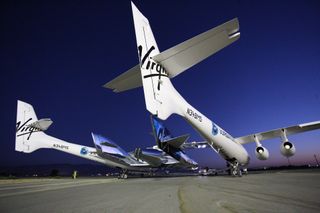
On Sept. 8, 2016, the private spaceflight and space tourism company Virgin Galactic flew its second SpaceShipTwo - the VSS Unity - for the first time in a captive carry test with its mothership the VMS EVE.
The test flight took off from the Mojave Air and Space Port in Mojave, California and lasted just under four hours. It was a major moment for Virgin Galactic: The company's first SpaceShipTwo - the VSS Enterprise - was lost during a tragic test flight accident in October 2014 that destroyed the spacecraft. The mission's co-pilot died in the crash and the surviving pilot suffered serious injuries.
In a Twitter statement, Virgin Galactic acknowledged the big emotions running through the entire team during the Sept. 8 test flight:
Check out more photos from Virgin Galactic's first VSS Unity captive carry test in this slideshow.
First Flight of VSS Unity

Virgin Galactic's SpaceShipTwo vehicles are designed to carry six passengers and two pilots on trips to and from suborbital space at a price of $250,000 per seat. The spacecraft is carried to launch altitude by its WhiteKnightTwo carrier plane, released so it can fire its rocket engine and ultimately glides back to Earth for landing.
During the Sept. 8 test Unity remained attached to its carrier plane at all times, but it did carry a two-pilot crew. Virgin Galactic pilots Mark Stucky and Dave Mackay were aboard the spaceship, while the VMS Eve mothership was flown by Mike Masucci and Todd Ericson, with Wes Persall serving as flight engineer. [Meet the Pilots of Virgin Galactic | Video]
The VSS Eve was built for Virgin Galactic by The Spaceship Company, a sister-company to Virgin Galactic that is also based at the Mojave Air and Space Port.
New SpaceShipTwo & Mothership Together
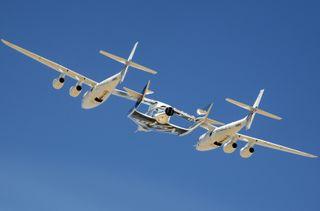
This photo, taken for Virgin Galactic by photographer Mark Greenberg, clearly shows how the company's WhiteKnightTwo carrier planes can carry SpaceShipTwo vehicles.
The VSS Unity (short for Virgin Spaceship Unity) is attached in the center of a massive wing on the twin-fuselage VMS EVE (Virgin Mother Ship Eve).
Virgin Galactic's WhiteKnightTwo is a four-engine aircraft and has a wingspan of 140 feet (nearly 43 meters).
The VSS Unity, meanwhile, was unveiled on Feb. 19, 2016, just over 15 months after the loss of the VSS Enterprise on Oct. 31, 2014. [Gallery: Virgin Galactic's VSS Unity Makes Its Debut]
A Major Test Flight
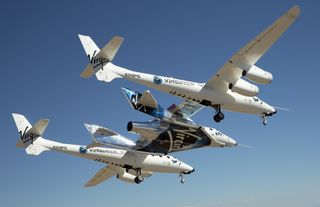
Virgin Galactic representatives said that captive carry tests like the one flown on Sept. 8 can offer key insights into a SpaceShipTwo's
From start to finish, the test ran about three hours and 43 minutes.
Closer to Space
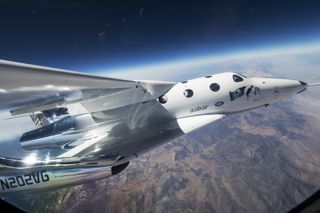
During the Sept. 8 test flight, the VMS Eve carried the VSS Unity up to an altitude of 50,000 feet (15,240 meters). That's launch altitude for a SpaceShipTwo.
Flying at that altitude was a key part of the test, mostly because of the temperatures Unity experienced:
First of Many Tests
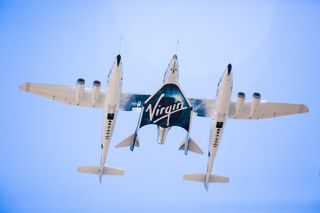
Unity and its Eve carrier plane returned to their Mojave airstrip on Thursday afternoon and appeared to have aced their initial captive carry flight, based on Virgin Galactic statements.
"With this flight in the books, our team will now analyze a mountain of flight data, learning what worked well and what could be improved for our next flight test. Only when that analysis is done, along with detailed vehicle inspections, some already-planned work, and potentially more captive carry flights, will we be ready to move into the next phase of test flight," Virgin Galactic representatives said in a statement.
How SpaceShipTwo Works

With the VSS Unity's first big test flight in the record books, Virgin Galactic will be forging ahead with its test flight program for the new space plane.
Here's a look at how Virgin Galactic's SpaceShipTwo vehicles will work to fly their passengers on suborbital spaceflights. Each SpaceShipTwo is designed to carry two pilots and six passengers to space and back.
The WhiteKnightTwo motherships, the first is called the Virgin Mother Ship Eve, or VMS EVE, carry the SpaceShipTwo (or VSS, for Virgin Space Ship) to launch altutude. There, the vehicle is dropped and ignites its rocket engine to carry its passengers into space.
A novel twin tail boom feather system aids in re-entry and the spacecraft then glides back to Earth for a runway landing.
Join our Space Forums to keep talking space on the latest missions, night sky and more! And if you have a news tip, correction or comment, let us know at: community@space.com.
Get the Space.com Newsletter
Breaking space news, the latest updates on rocket launches, skywatching events and more!

Tariq is the Editor-in-Chief of Space.com and joined the team in 2001, first as an intern and staff writer, and later as an editor. He covers human spaceflight, exploration and space science, as well as skywatching and entertainment. He became Space.com's Managing Editor in 2009 and Editor-in-Chief in 2019. Before joining Space.com, Tariq was a staff reporter for The Los Angeles Times covering education and city beats in La Habra, Fullerton and Huntington Beach. In October 2022, Tariq received the Harry Kolcum Award for excellence in space reporting from the National Space Club Florida Committee. He is also an Eagle Scout (yes, he has the Space Exploration merit badge) and went to Space Camp four times as a kid and a fifth time as an adult. He has journalism degrees from the University of Southern California and New York University. You can find Tariq at Space.com and as the co-host to the This Week In Space podcast with space historian Rod Pyle on the TWiT network. To see his latest project, you can follow Tariq on Twitter @tariqjmalik.